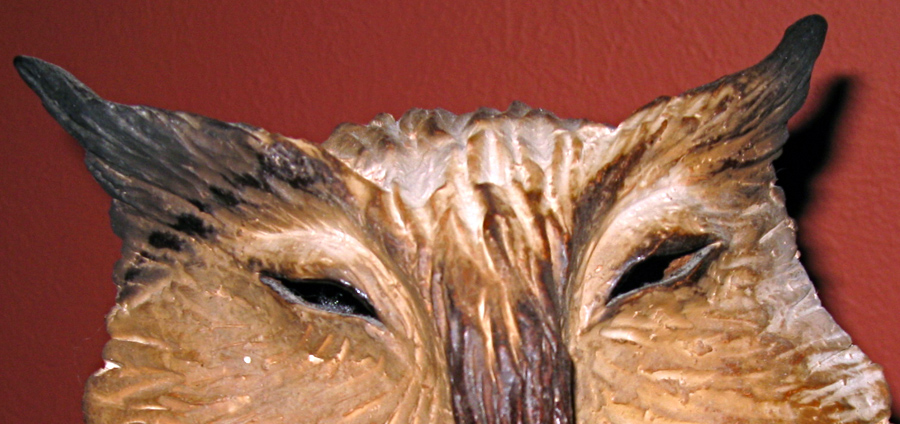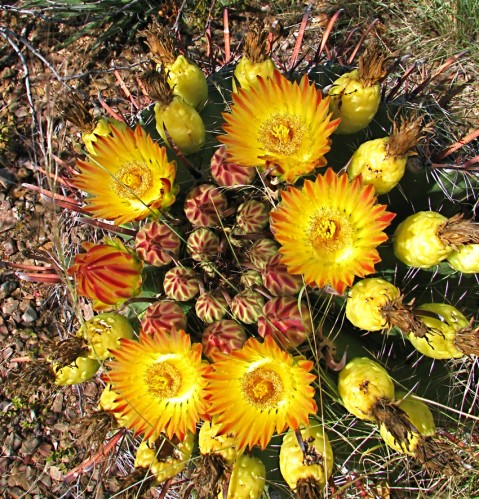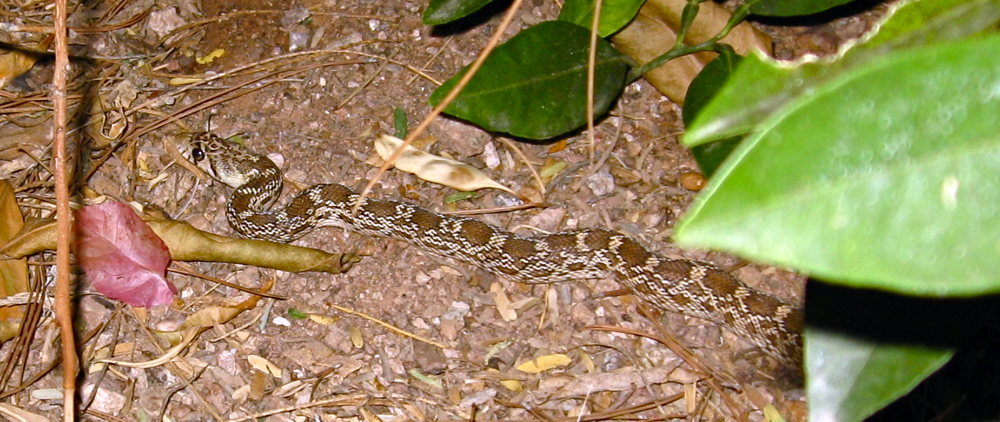The unfinished hive
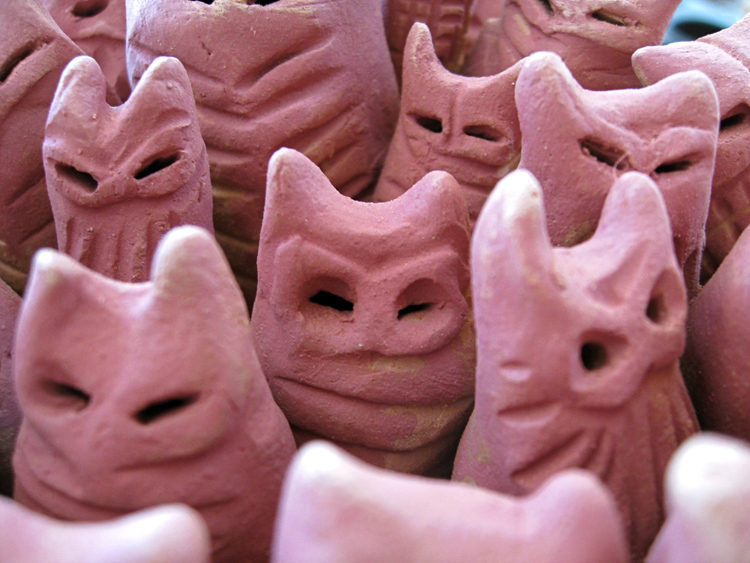 What if you had to raise large numbers of owls, herds of owls, swarms of tiny owls, all at once? What if that was your job? What would you need? You might need an Owl Hive. Or a cluster of Owl Hives.
What if you had to raise large numbers of owls, herds of owls, swarms of tiny owls, all at once? What if that was your job? What would you need? You might need an Owl Hive. Or a cluster of Owl Hives. What would an owl hive be like? Each hive would have to have entrances, so that the owls could fly in and out. There would have to be an interior chamber, so the owls could build their elaborate, communal owlcomb. There would have to be access for you the Owl Keeper, to extract whatever product the owl colony produced and stored inside, like vole honey or rabbit suede. It would need a lower hole to expel pellets and admit fresh air. At the very least, there would need to be a roof for the owls to land on, and a lofty perch from which to Keep an Eye on Things.
What would an owl hive be like? Each hive would have to have entrances, so that the owls could fly in and out. There would have to be an interior chamber, so the owls could build their elaborate, communal owlcomb. There would have to be access for you the Owl Keeper, to extract whatever product the owl colony produced and stored inside, like vole honey or rabbit suede. It would need a lower hole to expel pellets and admit fresh air. At the very least, there would need to be a roof for the owls to land on, and a lofty perch from which to Keep an Eye on Things.
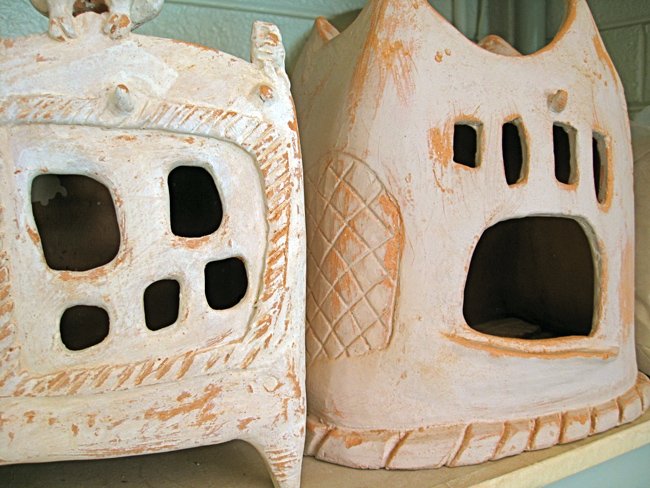 Here are some detail photos of unfinished architectural-effigy-nest-vessel-box objects in progress, some only bisqued, some completely innocent of the kiln as yet — the most recent Three Star Owl clay project. They might be Owl Hives. They might be sculpture or effigy vessels. They might be small ovens or incense censors. Or, they might be actors, waiting to be cast as archæological artifacts in an upcoming fiction post on this blog. Of course, they might be all of the above. Stay tuned to this location to see how it goes. (All photos and objects A.Shock)
Here are some detail photos of unfinished architectural-effigy-nest-vessel-box objects in progress, some only bisqued, some completely innocent of the kiln as yet — the most recent Three Star Owl clay project. They might be Owl Hives. They might be sculpture or effigy vessels. They might be small ovens or incense censors. Or, they might be actors, waiting to be cast as archæological artifacts in an upcoming fiction post on this blog. Of course, they might be all of the above. Stay tuned to this location to see how it goes. (All photos and objects A.Shock)
Three small pictures of four small things…
… I missed at first, when outside friday morning shooting passionflowers.
It really irked me to not have my own photo of a Gulf Fritillary to post yesterday, so once the sun was higher, I went out to fetch one, if possible (a photo, that is, not a flutterby). I ended up encountering not only the butterfly, but three other notable things. Here they are, in the order they appeared (be sure to click to enlarge, except the kestrel, which is too blurry to bother, and actually will just get smaller anyway; all photos A.Shock):
A. The Gulf Fritillary, which started it all. The insect is sort of hidden in the negative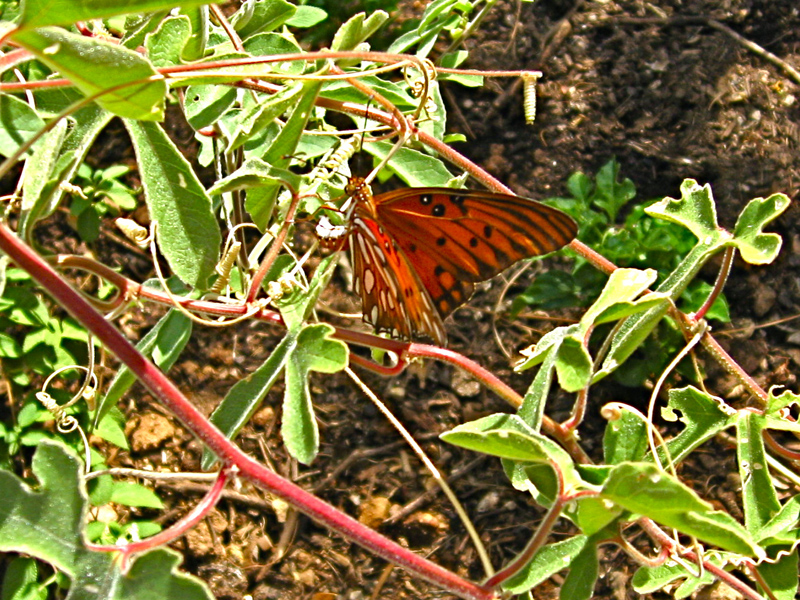 space between stems and leaves (almost a “Spot the Bird“). This was the best photo I was able to nab — the name flitirraries would suit them even better, because they never seem to rest. They are Passiflora specialists, and are clearly thrilled that we have four vines in the yard. (Well, six vines actually — this morning I found two small seedlings, thriving about 4 feet away from where their parent plant refused to take.) >>
space between stems and leaves (almost a “Spot the Bird“). This was the best photo I was able to nab — the name flitirraries would suit them even better, because they never seem to rest. They are Passiflora specialists, and are clearly thrilled that we have four vines in the yard. (Well, six vines actually — this morning I found two small seedlings, thriving about 4 feet away from where their parent plant refused to take.) >>
B. The Echinopsis in bloom (or “Easter Lily cactus”). This one is a cultivar, I don’t know which, since these shade-growing cactus have 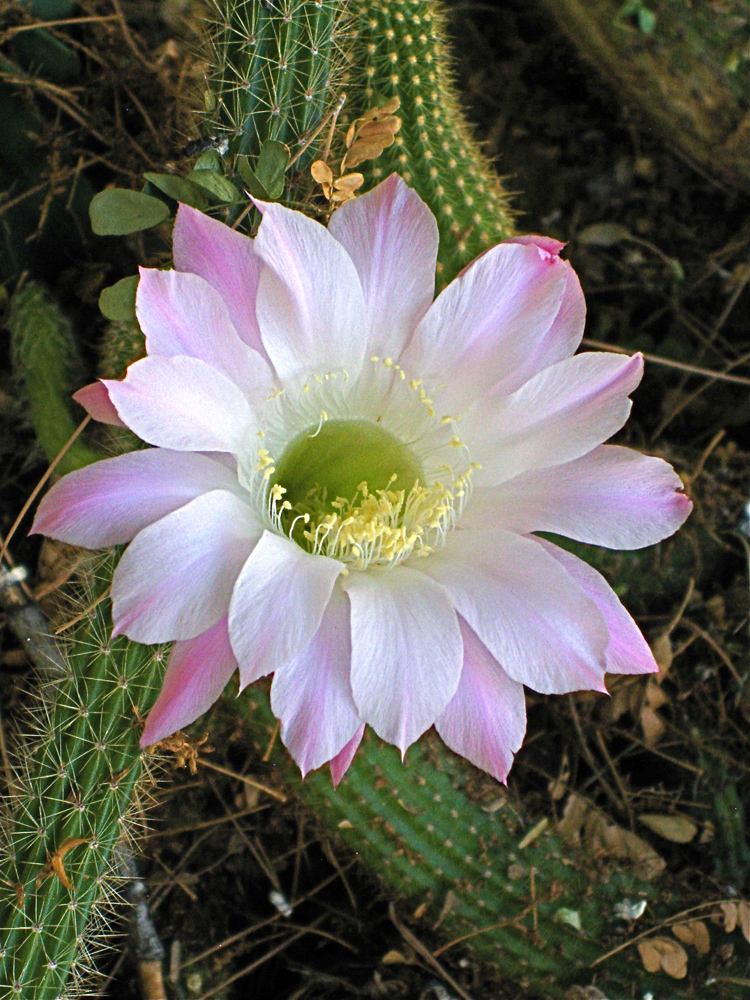 been living in this yard longer than we have. In my experience, it’s unusual to find its crepuscular flowers still open at noon. <<
been living in this yard longer than we have. In my experience, it’s unusual to find its crepuscular flowers still open at noon. <<
 C. The Fearsome Predator. >> The neighborhood male American Kestrel, about the size of a Mourning dove, checking out the Dee-licious Finch Bar (the birdfeeders) for lunch. I looked up when I heard a house sparrow give a rough alarm call; the little falcon was just 20 feet away from me, perched on a low wire with a good view of the menu. Unfortunately, I didn’t get a shot of him until he’d swooped up to the top of the corner phone pole because my trigger finger was distracted by D:
C. The Fearsome Predator. >> The neighborhood male American Kestrel, about the size of a Mourning dove, checking out the Dee-licious Finch Bar (the birdfeeders) for lunch. I looked up when I heard a house sparrow give a rough alarm call; the little falcon was just 20 feet away from me, perched on a low wire with a good view of the menu. Unfortunately, I didn’t get a shot of him until he’d swooped up to the top of the corner phone pole because my trigger finger was distracted by D:
D. The Ants that were biting me painfully on the feet. Due to hastily brushing them off and sweeping them out from under my sandal straps in a undignified quick-time version of the Myrmex Dance I did not immortalize their image, although they were just doing their job, Protecting The Nest, which I’d accidentally trodden upon trying to photograph the Echinopsis. Perhaps the Gilded Flicker family who lives here (and who, I think surprisingly late, just fledged a young’un) will be making a visit to the Dee-licious Ant Bar.
Do you suppose the Ant Bar has a Formica countertop?
Bonus etymology: Formica, etc.
According to the archives of “Word of the Day” — …Greek murmex [is] “an ant,” which also gives us myrmecology “the study of ants” and myrmecophagous “ant-eating.” In Latin the related word for ant was “formica,” from which we have the former Word of the Day “formication,” the sensation of ants crawling under the skin. The proprietary name “Formica” applies to a plastic laminate ultimately derived from formic acid (which comes from ants), but it is also a pun—it was originally developed as an electrical insulator that could be substituted “for mica.”
For the detail-oriented, let me add that Latin formīca is the ancestor of the French and Spanish words for ant, fourmi and hormiga, respectively. The Latin and Greek words formīca and myrmex (μύρμηξ) at first glance may not seem similar to each other, but as neatly summarized by Wikipedia, both are generally accepted to be derived from the Proto-Indo-European root *morwi- along with a pile of words for ant in other languages: Latin formīca, Iranian /moirbant, Avar maoiri, Sanskrit वम्र (vamra), Greek μύρμηξ (murmēks)/μυρμήγκι (mirmigi), Old Norse maurr, Crimean Gothic miera, Armenian մրջիւն (mrǰiwn), Polish mrówka, Albanian morr, Persian /murče, Old Church Slavonic mravie, Russian муравей (muravej), Tocharian /warme, Kurdish Mérú, Breton merien.
Purple in the herbs
Our vegetable garden, like most vegetable gardens, requires continual effort. For the majority of these domesticated types of plants, the desert is not a “shove it in the ground and it will grow” environment. Rabbits and diggy-beaked birds are constantly helping themselves, peak summer heat (now thankfully past) and dryness make frequent watering necessary. So, we pick our battles: tomatoes, no; herbs and chiles, yes.
There are also typical ironies of gardening. Plants that we cannot get to grow in spots we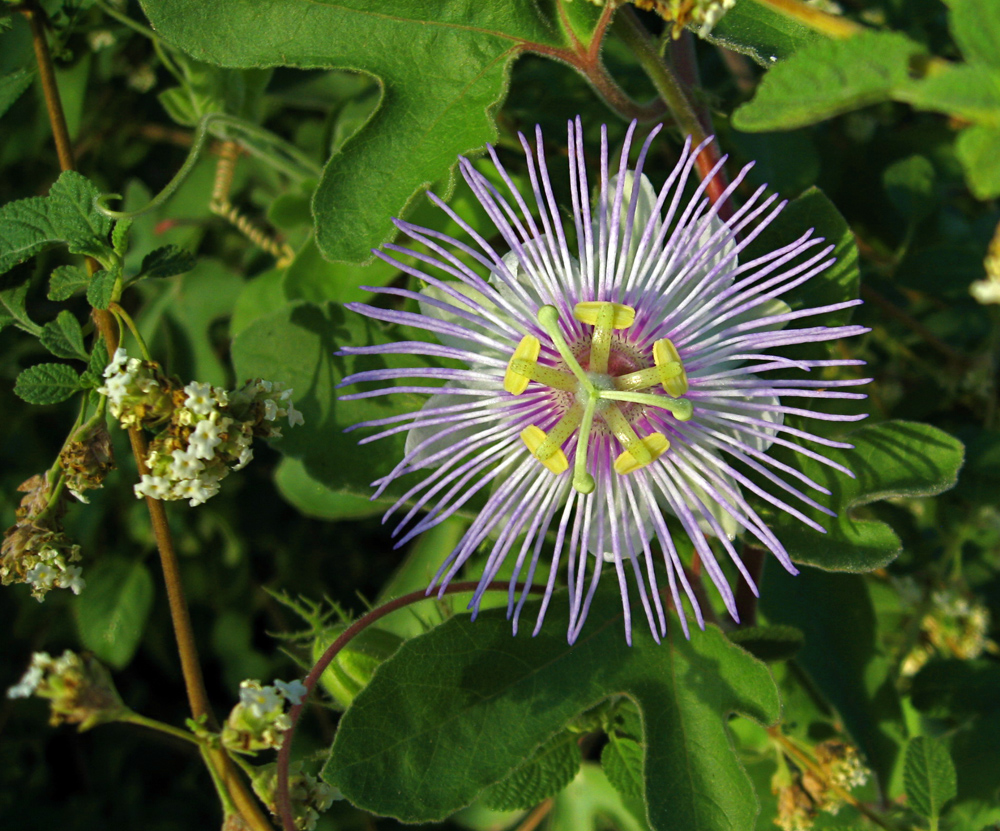 intend for them will flourish as volunteers in the most unlikely and sometimes inconvenient places.
intend for them will flourish as volunteers in the most unlikely and sometimes inconvenient places.
Passiflora foetida (Photo A.Shock) >>
The passionflower, Passiflora foetida, is an example. It will not grow on the fence we’d like it to hide; we’ve tried twice, it’s succumbed three times — once, after a miraculous Lazarus act accomplished by profligate watering, all the re-grown leaves were denuded by Gulf Fritillary caterpillars, which in the plant’s precarious resurgence, finished it off for good. (However, this fall our garden is full of gorgeous orange butterflies). Passionflower will grow untended — unwatered, even — between cracks in the pool deck, and, of course, in the vegetable garden, using the withered and sulky tomatoes as a support. Currently three volunteer passionflower vines (spawned from the beleaguered “lazarus” individual’s seeds) are boisterously and inconveniently twining through our herb garden. We let them; they seem so happy. Above is a photo of one blooming at dawn this morning, growing through another one of our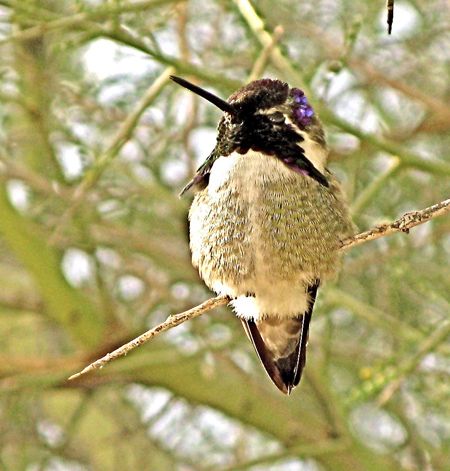 garden success stories, the Mexican oregano, with its less extravagant clusters of tiny white flowers.
garden success stories, the Mexican oregano, with its less extravagant clusters of tiny white flowers.
male Costa’s hummingbird, showing just a glint of purple behind his eye. In the right light, his entire gorget would gleam grape (Photo A.Shock) >>
Whether we get produce to the table or not, the garden is great habitat — young lizards abound, and this morning there was a spiffy male Costa’s hummer gnatting over the oregano, his moustaches way purpler than the lavender Passionflower he hovered over. Periodically he would rest, perching on a wire tomato cage, and sing his thin little wispy song, barely noticeable unless you know to listen for it. It’s their time of year: they seem to be the most numerous hummers in the yard, zipping around from perch to perch, chasing each other, “singing” and establishing their territories. News to interlopers: our garden, rich with suitable perches, flowers and tiny winged insects, is already claimed up.
The Week in Review: the last monsoon event?
Earlier in the week we had a storm — technically outside the officially designated monsoon season — and it was a colorful one. Our microcosm of Phoenix received about a half inch of technicolor rain in a very short time, without the wind and hail that the same towering clouds dropped on neighbors less than three miles to the east. The storm brought amazing sunset skies, migrants, optimistic amphibians, and flowers to our yard. (All photos E.Shock.)
without the wind and hail that the same towering clouds dropped on neighbors less than three miles to the east. The storm brought amazing sunset skies, migrants, optimistic amphibians, and flowers to our yard. (All photos E.Shock.)
Shortly after these clouds moved over the metro area, the dark skies split, pumping rain and lightning into the creosote-scented night air. 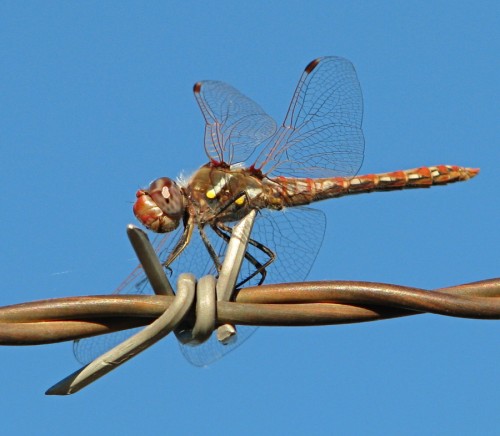
The next morning, we found an excellent red dragonfly drying its wings on barbed wire, “our” spadefoot wound up in the pool again along with the rest of the storm debris, awaiting rescue, and the Herrerrae barrel cactus’s crown of fragrant yellow and red blooms were saturated with color. The architecturally precise buds tautly await their turn in the vortex of the flower crown — the easier-going little lemony pine-apples slouching around the edge are last year’s fruits, 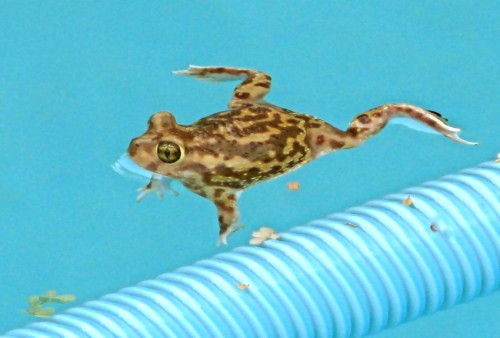 waiting to split open and disgorge their seeds, or be plucked and carried off by an herbivore, and left elsewhere to start a new barrel.
waiting to split open and disgorge their seeds, or be plucked and carried off by an herbivore, and left elsewhere to start a new barrel.
With luck, cactus and wildflower seeds all over the desert will be soaking up the fall moisture, preparing themselves for next spring’s blooming.
And it goes on…
It always makes me happy to see infant animals in the yard; it means the world is rolling along, as it should, species replenishing themselves and the natural systems functioning. This is why people love seeing babies — it gives the same satisfaction: that the world is carrying on as usual, despite everything, and because of everything. I feel it when seeing tiny cottontails hidden out in the open in their form, hatchling praying mantids swarming out of their bread-loaf egg-case, nest-cached hummingbirds waiting for mother to dispense nectar-and-gnat soup, even young raccoons trundling behind their mother, wreaking havoc in the yard, and young serpents making their way on the soil, searching for prey something the girth of a pencil can handle.
In the warm desert, a lot of this new life begins in fall, our functional second spring: ahead is the cool weather with its longer nights for foraging, the scorching hot temperatures are behind us. Monsoon is winding down too, a time when the intermittent deluges of late summer storms kick-start the food web after the stingy, dry weeks of early summer. This moisture encourages hatching and births, vegetation sprouts everywhere, and arthropod and rodent pray abounds, generously giving hungry young animals a solid start.
Yesterday, it was young lizards: the herb and vegetable garden we planted this year with its slightly raised-bed construction, bounded by hollow cinder blocks and stocked with minute invertebrate-rich compost, has proven to be a successful nursery for both Tiger whiptails and Ornate tree lizards. While watering, I watched three young tree lizards simultaneously hunting ants and other tiny prey: they would dash forward, whip out their tongue, swallow, and then slowly, sinuously wave their tails back in forth in an undulating movement — a slow-motion lash — that just looked like someone rubbing their hands in self-satisfaction. Each lizlet was only 2 inches long. A young whiptail, larger by species, but still young — its long tail was still faintly electric blue — was also puttering around in the vicinity, taking advantage of my shadow to hang out in the coolness of some overflow water from the beds.
This morning it was the young Gopher snake (above), about a foot long, but only as big around as a finger. Gophers are common in our yard, but I always admire how their yellow and chocolate pattern shifts subtly from head to tail, from yellow-on-brown to brown-on-yellow. You can’t tell where the change-over happens,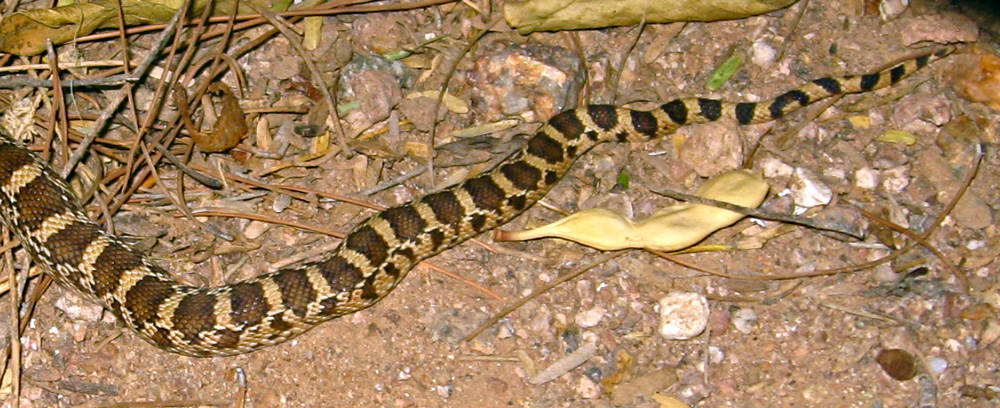 but the tail is positively different from the head.
but the tail is positively different from the head.
<< The change-over zone (Photo A.Shock)
Unfortunately, this beautiful pattern is the reason so many gopher snakes are killed by fearful people: it’s reminiscent of the diamond-pattern on rattlesnakes. Gophers (or bull snakes) are especially welcome here as efficient rodent predators; our part of the Phoenix area has been plagued with roof-rats for a decade or so.
This young’un in the photo above saw me before I saw it, and hid its head under an orange leaf, leaving the full length of its boldly patterned body out in the open. Here it is, sneaking slowly away in the hopes the looming predator (me) doesn’t notice.

